| | Since the year 2000, the Boylston Chess Club has been running Bryan Clark's sparkling invention, the Paramount Tournament. This annual 10-week (one round per week) tournament has a generous first time control and offers that rare bird - the adjournment. Last year's time controls were 40/120;d5, then G/50;d5. Each player got a chance to play both White and Black against the other players in their section (normally 6 players in each).
I recently exchanged e-mail about this tournament with a friend who left the area before the year 2000, and he commented, "Double Round Robin and adjournments? Has Boylston gone back in time to some Soviet-era style tournament?"
My crotchety self thinks, “When I started playing in chess tournaments back in 1985, we didn't have no increment or delay clocks. We had to wind our BHB clocks by hand, and we liked it. And we certainly didn't have no stinkin' strong, affordable chess programs.”
Well, actually some of Boylston's loaner clocks are still BHBs that need to be wound by hand. Today, I love increment/delay, and I also quite appreciate the iOS tChess Pro app pointing out gaps in my chess thought processes.
The Paramount tournament has had a couple of incidents related to time controls and adjournments, incidents which highlight how much things have changed since the 1980's.
Ed Astrachan and Greg Bodwin were playing a chaotic game and were approaching the first time control. Ed was very low on time and neither of them had been keeping score for some moves. There was some brief uncertainty about whether Greg could, without a complete record of the moves, claim a win on time if Ed's flag were to fall (he could not).
What shocked me was that after the game (which Ed won), Greg told me that he had never played in a tournament that had more than one time control (!!). How does a player get to a 1900 rating like Greg without having played a game with two or more time controls? When I started playing in tournaments, most or all had unlimited time controls, including the 1986 U.S. Open, where I resigned one game at 2:45 AM, after having played continuously for seven hours and forty-five minutes. For that game an adjournment had been offered to us but we both preferred to play on.
Affordable chess programs were quite weak back in those days. Without a strong player's assistance, assessment of adjournments could be very uncertain. One of my adjournments from the Boylston Chess Club, back when it was at it's YMCU location, was from this position:
Tim Maxwell - Ken Ho
2 April 1987
After 46. Kg3:
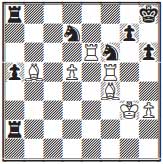
I had sealed 46...Ra3+, and pummeled my brain for some days but remained bewildered about whether I was worse or better. Sure, I had an extra passed pawn, but Tim had his own passed pawn and a pair of Bishops on a very open board. I eventually offered Tim a draw by phone before resumption, which he accepted. Ironically, here in today's world, iOS's tChess Pro assessed Black as worse by 0.18 pawns after 46. Kg3, but assessed the position as exactly equal after 46...Ra3+, intending repeated checks with 47. Kg2 Ra2+ 48. Kg1 Ra1+ 49. Kf2 Ra2+ 50. Kf1 Ra1+.
Fast forward to the present, to my game as Black against Ed Astrachan at the Paramount.
After mutual mistakes I ended up with the fragile advantage of two Knights versus a Rook, while each of us also had our respective f, g, and h pawns. Ed exchanged off his f-pawn for my g-pawn. After that, despite various maneuvering, I had trouble convincing myself that I would be able to make anything out of my minimal material edge.
Ed Astrachan - Ken Ho
23 April 2012
After 44. Ra5:
Having come back from a material disadvantage thanks to those darn tricky Knights and their forks, I decided to violate endgame principles and make an additional pawn exchange in hopes of getting Ed's Rook close enough for a magical series of surprising and deadly Knight moves. This is the "praying to Caissa" approach.
Subsequently, after 47...Kg5:
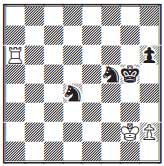
Before we reached this position, I was eminently aware that Ed could play 48. Rxh6, when we would be in the fabled Troitzky Line endgame. I’d given some thought as to whether I should try to engineer a particular board position for the possible adjournment, but hadn’t come to a definitive decision about what might be optimal.
My senses were particularly attuned to Ed's possible Rook sacrifice due to this previous experience:
Ken Ho - John Fanning
12 March 1988
After 56. Na5:
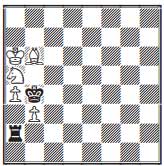
In that game I did not notice my opponent's Rook sacrifice possibility until just after having played 56. Nc4-a5. He did indeed play 56...Rxa4, which was of course followed by 57. bxa4 Kxa4. I did not prove up to the task of checkmating with Bishop and Knight, and was forced to concede the draw after move 99. Okay, perhaps I should not have accepted the beer he offered me (we played at the Framingham Chess Club in the American Legion hall, where libations were available), but the sad truth is that I have yet to learn the Bishop + Knight mate technique.
Back to Ho-Astrachan. Ed did take my last pawn with 48. Rxh6. He later shared that he had had some concern that if he hadn't sacrificed the Rook, I might be able to corner his King, advance my pawn to help contribute to making mating threats, all while shielding my own pawn with my Knights against capture by his Rook. However, he had felt both that possibility, and forcing mate in the Troitzky Line scenario (in which he thought forced wins were more rare than would seem to be the case), were both rather daunting tasks.
Let me first inject two pieces of Ludek Pachman's eminently human commentary on the Troitzky Line from his swell 1983 book Chess Endings for the Practical Player:
“If I found myself with this type of ending in a game, I would be very worried how to win (perhaps), the technique of winning is so hard! Besides there is another condition attached: The opposing pawn must not be too far advanced.”
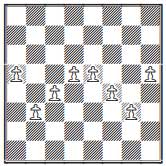
If the white pawn has advanced beyond any of the pawn positions shown above, a win is no longer possible (Pachman's original diagram concerned itself with Black pawns, but I show the case for White pawns here, which aligns with HoAstrachan). Pachman continues:
“That is all the reader should know about this end-game. It is also the limit of my own knowledge. If I ever blockade my opponent's pawn behind this border and have two knights, I will try and win, but I can hardly say with certainty, if I could indeed force the win.”
During the game I was aware of the existence of the X-piece Nalimov endgame table bases, which contain the optimal moves to force checkmate when a win is possible. I was pretty sure those were solved for all positions with 5 or fewer pieces.
As I learned after the game, they are solved where X is 6 (the number of pieces remaining on our board after 48. Rxh6) or fewer. Even more scary (or excellent) is the fact that access to these huge databases is available on the web, for free.
As Ed shared later, he was not fully aware of the state or availability of endgame table bases, or he might not have so lackadaisically sacrificed his Rook.
After 48.Rxh6:
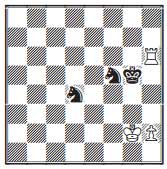
So, which way to recapture the Rook? Well, improvising "like Pachman" (Kenator, you're no Ludek Pachman. -Sam Lloyd Bentsen), I thought:
1) I want to maintain my Knights'
current restraint of the Black King.
2) The farther back I can restrain the pawn the better.
I considered that after 48...Nxh6 49. h4+ Kg4 50. h5, I might run into difficulties coordinating getting my h6 Knight back while not letting Black's pawn grow up "too soon." I was aware that it might be possible to allow the pawn to queen, yet checkmate White on the next move.
So I played 48...Kxh6?, after which the Nalimov table bases coldly tell me that it's now checkmate in the nightmarishly extended 93 moves.
After 48...Nxh6, it's checkmate in "a mere" 42 moves. Now, 42 still seems like quite a lot of moves. However, after 48...Nxh6, 49. h4+ would seem to be the most natural move, inasmuch as if Black can get rid of that pawn, he should get at least a draw. But "Mr. Nalimov" would tell you that it's now checkmate in the significantly fewer 31(!) moves. You darn well better check any complacency about the effectiveness of natural-looking moves at the door!
While investigating endgame table bases, I was reminded that Lewis Stiller had done early work on the 5-piece ones. I remember him telling me, back in the later 1980's, that it was difficult to get computing time for such analysis on that era's super computers.
Back to the game. After 48...Kxh6 49. h4 (Unlike after 48...Nxh6, this pawn move does not shorten the 93 move checkmate.)
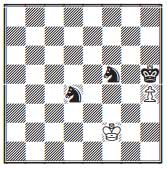
49...Kh5 50. Kf2 (The most natural-looking and best move; the horrible-looking 50. Kh1 and 50. Kh2 both "rightly" lose in the dramatically fewer 33 moves.)
I now considered that I had probably made a mistake with my earlier 48...Kxh6, since I saw that at this time I want my Knight in front of the pawn. Unfortunately, it looked like getting the Knight there would cost more critical moves. So I expected that I was probably faced with a very tight path to force checkmate, and I may have ruined my chances of doing so before Ed could claim a draw under the 50-move rule.
So, as I subsequently shared with Ed, having concluded after some thought that I had neither the motivation nor the time to try to memorize relevant Nalimov variations for an adjournment, I played the thunderingly decisive, pacifistically unambitious, and blazingly practical 50...Nxh4 to force the draw.
With the benefit of hindsight, the extra half-point might only have been within my reach had we gone down the 48…Nxh6 49. h4+ line and then adjourned. Even then, I would have had to have been able to gather common threads from the myriad remaining Nalimov possibilities. Ed would have been obliged to presume that I would have memorized the longest checkmate path, so he might gamble and choose one or more of the non-optimal paths in hopes that I wouldn't know or find the checkmate there.
The times, they have indeed a-changed. If you journey back in time to join us for double Round Robins and adjournments at the Boylston Chess Club's Paramount tournament, don't forget to pack the present day's advancements in endgame theory.
|